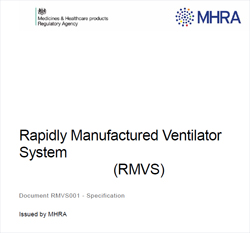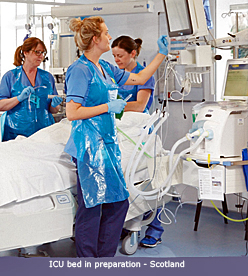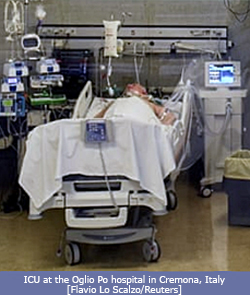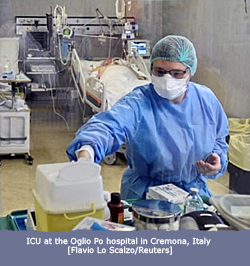 |
|
|
|
As previously reported by unionsafety, the Government have refused an invitation by the EU to take part in their speedy procurement of ventilators and PPE for use on the front-line of healthcare services treating those with the Coronavirus (Covid-19) pandemic. As a result, NHS England, the Government and the medical equipment regulatory authorities are panicking and asking manufacturers, never before producing ventilators to start to do so, and have issued what they term as 'minimum standards' for the production of a 'Rapidly Manufactured Ventilator System'. Ventilators must meet certain existing standards for MHRA approval. However, the DHSC said it was considering whether these can be “relaxed” given the urgency of the situation; reported The Guardian on 23rd March, following the publication of the document. But it seems from the document this has already been done.
'This is a specification of the minimally (and some preferred options) clinically acceptable ventilator to be used in UK hospitals during the current COVID-19 pandemic caused by SARS-CoV-2 virus. It sets out the clinical requirements based on the consensus of what is ‘minimally acceptable’ performance in the opinion of the anesthesia and intensive care medicine professionals and medical device regulators. It is for devices, which are most likely to confer therapeutic benefit on a patient suffering with ARDS caused by SARS-CoV-2, used in the initial care of patients requiring urgent ventilation. A ventilator with lower specifications than this is likely to provide no clinical benefit and might lead to increased harm, which would be unacceptable for clinicians. Intensive care medicine is a whole system of care and ventilators cannot be safely used on any patient without trained staff and other equipment and medicines. Where these impinge on the specification they are mentioned below. ' But, the devil is in the detail they say, and here is an issue of serious concern that many may not have considered. These rapidly produced ventilators are clearly not meant to be of the same standard found elsewhere in NHS hospitals, nor is their use intended for the duration of required individual patient care, but as a temporary stop-gap! 'It is proposed these ventilators would be for short-term stabilisation for a few hours, but this may be extended up to 1-day use for a patient in extremis as the bare minimum function. Ideally it would also be able to function as a broader function ventilator which could support a patient through a number of days, when more advanced ventilatory support becomes necessary.' But the Government document admits it does not know quite a number of things that are pertinent to the effectiveness of these machines, and also alerts the NHS to a possible shortage too of not only ventilators, but of back-up required for each ventilator. In a section at the end of the 'Rapidly Manufactured Ventilator System' specification document, is a list of 'Unknown Issues': 1. How plentiful is 4 bar oxygen supply? Irrespective of the status of the above 'unknowns' the Government have chosen the design required to be built and already Penlon are providing anesthesia ventilators, usually meant for use in operating theatres, to complement the available 5,000 ICU machines. The Guardian reports that 'Smiths Group already makes one of the designs, its portable “paraPac” ventilator, at its Luton site, and said it was in discussions with the government to help make 5,000 ventilators in the next two weeks.'
According to a study published in November 2019 by EC Pulmonology And Respiratory Medicine ' ICU ventilators are better equipped with leak compensation and are known to compensate for large air leaks from the lungs or around airway tubing in the ICU setting. Monitoring facilities on ICU ventilators are adapted to function in these unusual circumstances to prevent an excess of false alarms. In contrast there are multiple exposed connections which are subject to disconnection or misconnection, kinking, or obstruction in anaesthesia workstation, small leaks inherent to such systems make low flow anaesthesia difficult.' A previously published web article entitled 'Ventilation In The Intensive Care Unit, Chapter 10' explaining the differences between anaesthesia ventilators, used in operating rooms for short-term needs, and those used ion an Intensive Care Unit, explains the difference in the two types of ventilators. For many reading this, it will bring into question the suitability of portable and anesthetic ventilators in the care of patients with damaged and badly functioning lungs: 'Ventilators used in anaesthesia were primarily designed to replace the minute ventilation of a patient with healthy lungs who is paralyzed or has a depressed respiratory drive as a result of anesthetic agents and opiates. In contrast intensive-care patients are normally encouraged to breathe alongside the mechanical ventilatory support which is gradually reduced during a slow weaning phase. Large air leaks from the lungs or around airway tubing are more common in the ICU setting, and monitoring facilities on ICU ventilators have to be adapted to function in these unusual circumstances to prevent an excess of false alarms. Nonetheless, the flexibility of modern ICU ventilators is utilizable and sometimes indispensible in the operating theatre and modern anaesthesia ventilators are increasingly equipped with features of an ICU type ventilator. ' Covid-19 patients require sustained and lengthy times on a ventilator when recovering from Covid-19 according to reports from across the world in countries battling to save lives. A point that is most applicable to all Coronavirus patients, and not just those with the Covid-19 form of the disease: 'Ventilation for prolonged periods of time may require humidification techniques other than the simple heat and moisture exchanger commonly found in the operative setting. These alternative techniques such as hot water humidifiers are associated with increased accumulation of fluid in the respiratory circuits, which may compromise ventilator function. Large air leaks from the lungs or around airway tubing are more common in the ICU setting, and monitoring facilities on ICU ventilators have to be adapted to function in these unusual circumstances to prevent an excess of false alarms. Nonetheless, the flexibility of modern ICU ventilators is utilizable and sometimes indispensible in the operating theatre and modern anaesthesia ventilators are increasingly equipped with features of an ICU type ventilator.'
Equipment that may be used on an ICU includes:
For Coronavirus (Covid-19) patients, all of the above will be required! The spectre of mass-produced lower standard ventilators, or those meant for different settings other than in an ICU, being utilised by the NHS in their care of Covid-19 patients who need life-saving treatment, is akin to that of the mass produced 'Trabi' car of East Germany which was famous for breaking down more often than working with parts so expensive, owners were simply dumping their broken cars at the roadside! With changes to the death certification system and removal of juries from Coroner Courts, there appears no way that the loved ones of those dieing form the pandemic of Covid-19, was due, in part, to not having been given ventilation via high quality machines, or one of the 'Trabi-like' rush manufactured 1 day use only ventilators with lower capability and specifications! Source: MHRA / The Guardian / EC Pulmonology And Respiratory Medicine / Clinicalgate / NHS / NHS Scotland / Al Jazeera
|


 b. If consumption in the range 1-2 l/min is acceptable then a wider range of designs is possible, but some very basic designs are not.
b. If consumption in the range 1-2 l/min is acceptable then a wider range of designs is possible, but some very basic designs are not. But the needs of a Covid-19 patient unable to breathe due to the huge build up of fluid in the lungs is akin to those suffering from severe pneumonia, is entirely different from that of someone needing quick and short-term ventilation, provided by portable and anesthesia machines.
But the needs of a Covid-19 patient unable to breathe due to the huge build up of fluid in the lungs is akin to those suffering from severe pneumonia, is entirely different from that of someone needing quick and short-term ventilation, provided by portable and anesthesia machines.  The NHS website explains fully, the type of equipment needed in an ICU involving the use of ventilators:
The NHS website explains fully, the type of equipment needed in an ICU involving the use of ventilators: